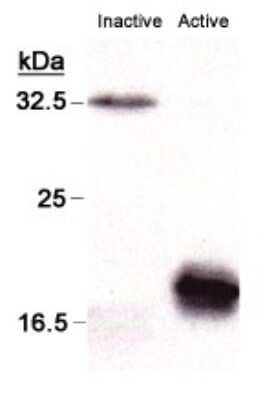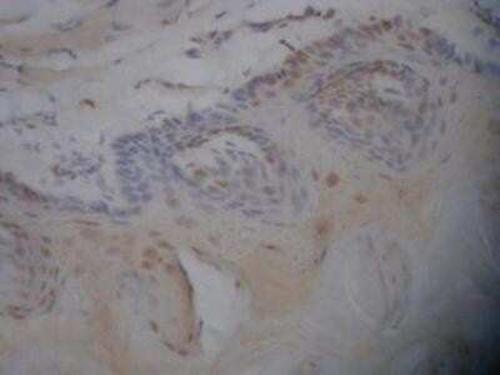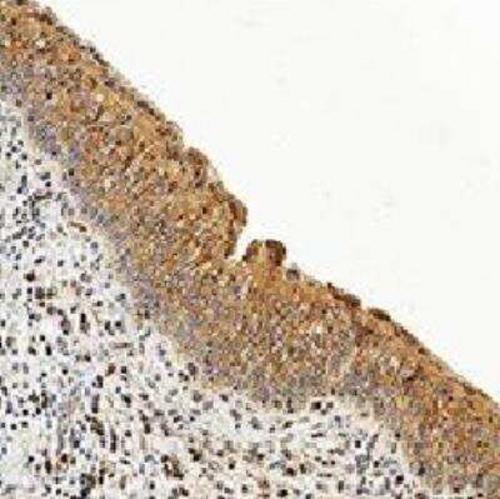Caspase 3 (CASP3) Mouse Monoclonal Antibody [Clone ID: CPP32 4-1-18]
CAT#: TA301776
Mouse Monoclonal Antibody against Caspase 3 (CPP32 4-1-18)
Need it in bulk or conjugated?
Get a free quote
CNY 5,381.00
| Cited in 8 publications. |
CNY 300.00
CNY 1,430.00
CNY 2,900.00
CNY 3,080.00
CNY 9,998.00
CNY 3,080.00
Specifications
| Product Data | |
| Clone Name | CPP32 4-1-18 |
| Applications | ICC/IF, IHC, IP, Simple Western, WB |
| Recommend Dilution | Immunohistochemistry-Frozen, Western Blot: 1:500-1:1000, Simple Western: 1:2000, Immunohistochemistry-Paraffin: 1:10-1:500, Immunohistochemistry: 1:200-1:500, Immunoprecipitation: 2 ug / mg lysate, Immunocytochemistry/ Immunofluorescence: 2 ug/ml |
| Reactivity | Human |
| Host | Mouse |
| Clonality | Monoclonal |
| Immunogen | Full-length recombinant human Caspase 3 protein. |
| Formulation | 0.1% sodium azide |
| Purification | Affinity purified |
| Conjugation | Unconjugated |
| Storage Condition | Store at -20°C as received. |
| Gene Name | caspase 3 |
| Database Link | |
| Background | Caspases are cysteine proteases, expressed as inactive precursors, that mediate apoptosis by proteolysis of specific substrates. Caspases have the ability to cleave after aspartic acid residues. There are two classes of caspases involved in apoptosis; initiators (activation by receptor cluster) and effectors (activation by mitochondrial permeability transition). Proapoptotic signals autocatalytically activate initiator caspases, such as Caspase-8 and Caspase-9. Activated initiator caspases then process effector caspases, such as Caspase-3 and Caspase-7, which in turn cause cell collapse. |
| Synonyms | CPP32; CPP32B; SCA-1 |
| Reference Data | |
| Protein Families | Druggable Genome, ES Cell Differentiation/IPS, Protease |
| Protein Pathways | Alzheimer's disease, Amyotrophic lateral sclerosis (ALS), Apoptosis, Colorectal cancer, Epithelial cell signaling in Helicobacter pylori infection, Huntington's disease, MAPK signaling pathway, Natural killer cell mediated cytotoxicity, p53 signaling pathway, Parkinson's disease, Pathways in cancer, Viral myocarditis |
Citations (8)
| The use of this Antibodies has been cited in the following citations: |
|---|
|
3-Bromopyruvic acid regulates glucose metabolism by targeting the c-Myc/TXNIP axis and induces mitochondria-mediated apoptosis in TNBC cells
,null,
Experimental and Therapeutic Medicine
,PubMed ID 35837063
[CASP3]
|
|
Tropical lichen, Dirinaria consimilis, induces ROS-mediated activation of MAPKs and triggers caspase cascade mediated apoptosis in brain and cervical cancer cells
,Shendge, AK;Panja, S;Mandal, N;,
Molecular and cellular biochemistry
,PubMed ID 33555513
[CASP3]
|
|
A natural flavonoid, apigenin isolated from Clerodendrum viscosum leaves, induces G2/M phase cell cycle arrest and apoptosis in MCF-7 cells through the regulation of p53 and caspase-cascade pathway
,Shendge, AK;Chaudhuri, D;Basu, T;Mandal, N;,
Clin Transl Oncol
,PubMed ID 32715386
[CASP3]
|
|
The carbonic anhydrase IX inhibitor SLC-0111 sensitises cancer cells to conventional chemotherapy
,Andreucci, E;Ruzzolini, J;Peppicelli, S;Bianchini, F;Laurenzana, A;Carta, F;Supuran, CT;Calorini, L;,
J Enzyme Inhib Med Chem
,PubMed ID 30362384
[CASP3]
|
|
An ellagic acid isolated from Clerodendrum viscosum leaves ameliorates iron-overload induced hepatotoxicity in Swiss albino mice through inhibition of oxidative stress and the apoptotic pathway
,Shendge, AK;Basu, T;Panja, S;Chaudhuri, D;Mandal, N;,
Biomed. Pharmacother.
,PubMed ID 29990833
[CASP3]
|
|
Defective activation of the MAPK/ERK pathway, leading to PARP1 and DNMT1 dysregulation, is a common defect in IgA nephropathy and Henoch-Schönlein purpura
,Milillo, A;Molinario, C;Costanzi, S;Vischini, G;La Carpia, F;La Greca, F;Rigante, D;Gambaro, G;Gurrieri, F;Sangiorgi, E;,
J. Nephrol.
,PubMed ID 29497996
[CASP3]
|
|
A natural antioxidant, tannic acid mitigates iron-overload induced hepatotoxicity in Swiss albino mice through ROS regulation
,Basu, T;Panja, S;Shendge, AK;Das, A;Mandal, N;,
Environ. Toxicol.
,PubMed ID 29446234
[CASP3]
|
|
YM155 down-regulates survivin and XIAP, modulates autophagy, and induces autophagy-dependent DNA damage in breast cancer cells
,Cheng, S;Chang, Y;Liu, C;Lee, J;Chan, H;Kuo, C;Lin, K;Tsai, S;Chen, S;Li, C;Leung, E;Kanwar, J;Huang, C;Chang, J;Cheung, C;,
Br. J. Pharmacol.
,PubMed ID 25220225
[CASP3]
[Human; WB] |
Documents
| Product Manuals |
| FAQs |
| SDS |
Resources
| 抗体相关资料 |
其它Caspase 3产品


 United States
United States
 Germany
Germany
 Japan
Japan
 United Kingdom
United Kingdom
 China
China





